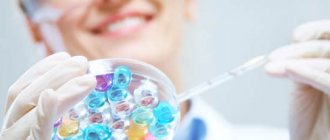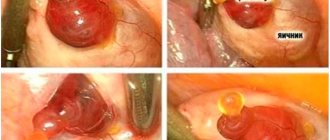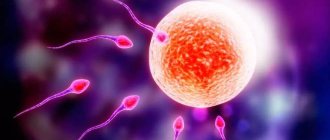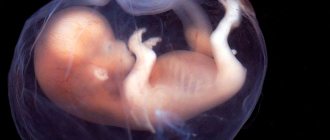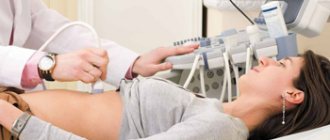What precedes fertilization
Before a female gamete meets a male one, a number of important events occur in the body:
- the egg and sperm reach maturity;
- a mature egg leaves the follicle (ovulation occurs);
- ejaculation occurs, during which seminal fluid with male reproductive cells is released into the female reproductive tract (most of the sperm fail to survive and overcome this path);
- capation of male germ cells occurs (spermatozoa are activated, acquiring the ability to penetrate the membrane of the egg).
The process of fertilization and pregnancy
Before the birth of a new life, a bunch of sperm rushes through the fallopian tubes. However, like a bunch - several million. An egg moves towards them. She is ripe and completely ready for fertilization.
Nature provided for natural selection already at this stage of existence. Only the strongest, fastest and most resilient penetrate the egg; the rest die.
After contact of the sperm with the egg, a zygote appears . This is the foundation from which the future man will develop. At this very moment pregnancy begins.
begins to fragment almost immediately after its appearance . The fact is that initially it is just one cell, and for the full formation of an embryo, the zygote must increase in size and become multicellular.
Sperm movement
During sexual intercourse, about 300 million male reproductive cells end up in the vagina, but only one of them, the most active and viable, manages to reach the egg. These colossal losses are dictated by nature:
- after sexual intercourse, a huge amount of sperm contained in the semen fluid flows out of the woman’s genital tract;
- another part of the male reproductive cells is destined to die in the acidic environment of the vagina;
- other sperm losses are caused by exposure to cervical mucus during passage through the cervical canal of the cervix;
- part of the male germ cells gets stuck in the mucous membrane of the cervix, being the so-called reserve group: they will move towards the egg if the first group does not meet the egg.
An egg can only be fertilized after ovulation occurs. However, when having sexual intercourse before ovulation, stuck sperm can wait for the egg to leave the follicle, remaining in the female body for 1-7 days. Thus, pregnancy can occur before and after ovulation.
Indirect
Additional symptoms do not bring much benefit, since they do not directly talk about pregnancy, and they take a lot of strength from the woman. First of all, this is a change in the psycho-emotional state of the expectant mother. Not only do hormonal changes occur in the body, but also a lot of fears and concerns arise.
- How will your husband react? This also includes mother, girlfriends, close and distant relatives.
- Will we be able to support the child financially? In modern conditions, fear is completely justified.
- Will I be able to carry and give birth to a healthy baby? Any normal mother worries about the condition of her offspring.
So it turns out that the expectant mother becomes irritable, she is constantly nervous, she is overcome by doubts and contradictions.
Other indirect signs are somewhat reminiscent of a developing cold . The woman suffers from insomnia, which, by the way, increases her emotional stress. Body temperature can remain at 37.5 for some time.
There’s nothing wrong with that , it’s just the beginning of hormonal changes in the body. Constant nasal congestion is also associated with this. If you suspect pregnancy, then when these signs appear you need to go to the doctor.
Nothing dangerous , but if suddenly it really turns out to be a cold, then the unborn child risks suffering.
Ovulation
Two weeks before the start of menstruation, no matter how many days the menstrual cycle lasts, a woman should normally ovulate. In a cycle of 27 to 28 days, the egg leaves the follicle approximately halfway through the cycle. The duration of a woman’s menstrual cycle varies from person to person; in some cases it lasts up to 45 days or longer. Therefore, it is advisable to calculate the date of ovulation taking into account the expected start of a new menstruation, counting 14 days from this day.
Ovulation occurs in the form of a kind of small explosion: after the rupture of a follicle filled with follicular fluid, the egg that has matured in it is released into the abdominal cavity.
When can you talk about conception with discharge after ovulation?
The menstrual cycle of every woman, if it is caused by ovulation, is divided into two phases, while the anovulatory cycle has one phase. Thus, in the first phase, the female hormone estrogen dominates, while the second phase of the cycle is controlled by progesterone, which will be responsible for pregnancy.
Consequently, with the help of basic hormones, all significant changes in a woman’s body will occur throughout her life.
Based on this, progesterone after conception will be responsible for all biological processes that will affect the growth and development of the child in the womb.
If, after ovulation has occurred, you notice that the amount of discharge from the genital organs has increased, then this should be considered the norm, since this stage is the start on the path to successful conception.
Such discharge, compared to normal discharge before ovulation, may differ and be of a different nature:
- beige discharge;
- pink discharge;
- yellow discharge;
- clear liquid with a small amount of blood;
- bloody issues.
In this case, if you notice some bleeding during or immediately after ovulation, then this phenomenon is observed during conception, when the fertilized egg penetrates the wall of the uterine cavity, injuring the blood vessels. If the process is observed on the sixth or twelfth day after successful fertilization of the egg, the discharge may look like spotting and have a characteristic brown tint. This indicates that conception has occurred and you will become a mother.
If you want to become a mother, you start preparing for the process in advance. You need to be examined by a gynecologist and pass all tests. This is important so that the child grows and develops normally without pathologies.
Be sure to get tested to determine the level of hormones in your blood. This will be the key to normal ovulation, conception and pregnancy.
After all the main preparation points have been completed, it is worth understanding the different signals that the female body can give, which will indicate the onset of pregnancy.
How the egg is transported into the fallopian tube
After leaving the follicle, the egg, surrounded by follicular cells, remains on the surface of the ovary. It is then captured by the fimbriae of the fallopian tube, the cilia of which help move the cellular conglomerate inside the tube. Activation of the cilia of the epithelium occurs under the influence of estrogens, which are released by the ovary after ovulation. At this stage, the egg is surrounded by cumulus cells, which form the corona radiata. During fertilization, sperm overcome this layer to penetrate the outer layer of the egg.
Exceptions to the rules
We have already looked at the general signs of early pregnancy; they are found in the vast majority of expectant mothers. But there are peculiar symptoms , let’s say, exceptions to the rules. Such symptoms are quite rare, and are not always perceived by a woman as a signal that conception has occurred.
- Changes in libido. Hormonal changes affect the level of sexual desire. It can either rise or fall, and women rarely associate this with fertilization.
- Atypical menstruation. With the onset of pregnancy, periods do not always disappear immediately; sometimes they simply change slightly before disappearing completely. The discharge changes in degree of abundance, and an unusual odor is mixed in with it.
- Early toxicosis. It usually occurs at 6-7 weeks of pregnancy, but in rare cases it begins at 10-20 days. Most often it is not very abundant, but there are exceptions.
- Frequent trips to the toilet. The growing uterus and its pressure on the bladder have nothing to do with it, the period is too short. The reason lies in hormonal surges.
These symptoms can confirm the main signs of pregnancy.
As soon as a woman becomes confident in her new status, she needs to begin to closely monitor her health, because the well-being of the unborn baby is in her hands!
Fusion of gametes
The fertilization process occurs in the ampulla of the fallopian tube, which is located near the ovary. Only a small part of male reproductive cells manage to reach this place. Overcoming the corona radiata, they reach the outer layer of the egg - the zona pellucida. Then they attach to receptors on the surface of the female reproductive cell and the release of proteolytic enzymes begins, due to which the white membrane dissolves and the sperm passes through the protective layer. Between the protective membrane and the inner membrane of the egg there is a thin layer of fluid that separates the sperm from the egg.
The sperm that manages to reach the inner membrane first attaches to it, its membrane fuses with the membrane of the egg and the sperm enters the egg. This event is accompanied by biochemical reactions that cause changes in the shell. No sperm has the opportunity to attach to it anymore. As a result of the release of substances by the fertilized egg that repel other sperm, it becomes impenetrable to them.
Signs of conception by day
The first two weeks after fertilization are characterized by active changes in the body. The embryo goes a long way from attachment to the endometrium to the beginning of the formation of internal organs. Let's look at the main symptoms of successful egg fertilization by day.
First day
The sperm travels through the fallopian tube to the egg. After this, the gametes merge to form a zygote. This period is not accompanied by any clinical symptoms.
Time of egg fertilization
Women who dream of getting pregnant often ask the question: “How long does it take for an egg to fertilize?” The answer is simple: the most favorable period for fertilization is 24 hours after the release of the female reproductive cell from the follicle (after ovulation), which is the best time for fertilization of the egg. Otherwise, this period of time is called the “fertile window”.
However, this does not mean at all that a woman has only 24 hours to conceive. Due to the fact that sperm do not lose their viability in the female body for up to five days, pregnancy can occur if sexual intercourse occurs three to five days after ovulation.
The time of fertilization of the egg is also influenced by a number of factors: the woman’s age, alcohol abuse, smoking, etc.
However, fertilization of an egg does not always mean pregnancy, since not every embryo has the ability to successfully attach to the wall of the uterus and implant into it, which in some cases is due to the presence of chromosomal abnormalities. An embryo with an incorrectly formed genome often dies before or after implantation and is excreted through menstrual flow.
When do the first signs of pregnancy appear?
You can reliably find out whether conception has occurred no earlier than two weeks after ovulation. Before menstruation, women often experience symptoms characteristic of pregnancy. Among these are:
- nausea and heartburn;
- increased appetite;
- tension in the abdomen;
- increased vaginal discharge;
- constipation and bloating.
On days 9-10 after conception, you can take a blood test for hCG. In the absence of pregnancy, it will be negative. An increase in human chorionic gonadotropin levels occurs only after conception, since it is produced by the chorion (the embryonic membrane from which the placenta will form in the future). The hormone in the urine begins to increase after a missed period, so tests always show a positive result later than a blood test. The main sign of conception is the absence of menstruation. The new position can be confirmed in 1-2 weeks by ultrasound. You can feel pregnancy for sure only when the woman begins to feel the motor activity of the fetus.
Signs of conception in the early stages do not appear in all women. In some they are more pronounced, while in others they are completely absent. If a girl does not have new symptoms after fertilization, this is not a reliable indicator of the absence of pregnancy.
Unenlightened people believe that pregnancy can only be determined through a medical examination or at the moment when a woman’s stomach becomes very enlarged and toxicosis begins. This is not so; the first symptoms of conception are noticeable shortly after “successful” sexual intercourse. Moreover, a girl who has already undergone pregnancy and childbirth will be able to determine the moment of fertilization herself . For her, these signs are natural and joyful, because she will soon become a mother!
Artificial fertilization of eggs
Today, thanks to the development of assisted reproductive technologies, in particular IVF, it is possible to fertilize an egg in an embryological laboratory. This method was developed for couples suffering from infertility, including if the problem with conception is due to ovulation disorders.
In vitro fertilization involves the fusion of female and male gametes in vitro, outside the female body, the cultivation of embryos and their subsequent transplantation into the uterine cavity of the expectant mother. Before transfer to the uterus, embryos can be examined for the presence of certain genetic diseases, thereby increasing the efficiency of fertilization and successful implantation, and also eliminating the birth of a child with congenital malformations. This analysis is called preimplantation genetic diagnosis and is carried out in almost every modern reproduction center.
The IVF Center clinic in Smolensk deals with problems related to infertility. The clinic uses both traditional treatment methods and ART methods: IVF, ICSI, IMSI, PGD, artificial insemination. If there are contraindications to the use of their own germ cells in IVF, the couple can use donor gametes and also become a participant in the surrogacy program.
You can make an appointment by phone or on the website of the IVF Center clinic by filling out an application form indicating contacts for feedback.
What other discharge may be observed after ovulation?
As for brown discharge after ovulation, this is a harbinger that you are pregnant, but along with them, other phenomena may be observed that confirm the fact. Some doctors believe that white discharge is indisputable evidence of pregnancy in a woman.
In order for the embryo to grow and develop comfortably, the discharge from the uterine cavity becomes viscous and thick - this is due to an increase in the hormone progesterone. This is also necessary to form a mucus plug, which will prevent the penetration of pathogenic microorganisms into the uterine cavity, infecting the fetus.
Leucorrhoea is not always a sign that a woman is pregnant. This may indicate an inflammatory process, especially if there are alarming symptoms:
- cutting sensation when going to the toilet;
- uncharacteristic pungent odor from the vagina;
- itching or cutting sensations;
- the presence of peculiar clots and cervical fluid.
Thus, discharge after ovulation, if conception has occurred, should not be accompanied by these manifestations, since this will not indicate conception, but an inflammatory process of the female genital organs.
If you are sure that you are pregnant and notice alarming symptoms, you should consult a doctor, since self-medication is not the best way out.
How long do sperm live under different conditions?
How long do sperm live in different conditions after ejaculation:
- They live in the vagina no longer than 2 hours. The natural environment for the vagina is acidic. This is due to its disinfecting functions; tadpoles can die in it within 20 minutes. In alkaline conditions (for example, douching with a weak soda solution), sperm will live for a maximum of 2 hours.
- In air, on the penis, on a condom and in a condom they die after 15 minutes.
- In a condom with spermicidal lubricant they die instantly.
- In ejaculate (seminal fluid), if stored in a sterile jar (relevant, for example, for taking a spermogram), sperm live no more than 2 hours.
- Sperm caught on bedding die almost instantly due to contact with air and lack of moisture.
How long sperm live is influenced by the man’s health, the woman’s lack of inflammation, and the temperature of the room where sexual intercourse occurs. At temperatures above 37 degrees they die.
Stages of conception
As mentioned above, conception is not a one-time process. It takes some time and consists of several stages. The absence of failures at each stage is a prerequisite and the key to a successful start to pregnancy. After all, only after the fertilized egg penetrates the uterine wall can conception be considered successful.
Many expectant mothers, wanting to quickly find out about the success of the predicted pregnancy, study the stages of conception by day. It is worth noting that each organism is individual, so slight shifts in the timing of these processes in the body are possible.
This process includes the following stages:
- ovulation;
- fertilization;
- cell division and movement through the tubes, ending with implantation.
Path of the sperm
Before we tell you how conception and fertilization occur, we will briefly consider the features of the “journey” of sperm to the egg. After ejaculation, several million male reproductive cells enter the vagina. The most active of them begin to move along the female reproductive tract to the uterus. At the same time, they need to overcome several obstacles.
The first of these is cervical mucus. Its consistency does not always allow sperm to penetrate into the uterine cavity, but during the period of ovulation the conditions for this are optimal. Having passed the cervix, the sperm penetrate into the uterus, from where they are sent to the fallopian tubes. In most cases, fertilization of the egg occurs here.
The process of fertilizing an egg
For fertilization of a woman’s egg to occur, the male reproductive cell must successfully overcome the cells of the corona radiata and the membrane itself. When the sperm comes close to the egg, its signaling substances recognize the head cells and an acrosomal reaction occurs. This process fuses the acrosome with the outer membrane, releasing enzymes that dissolve the egg membrane.
Sperm attempt to penetrate the membrane of the egg, but only one can fertilize it. The rapprochement of the male and female nuclei of germ cells occurs 12 hours after fertilization.
As a result of these processes, the genetic material is combined and a zygote is formed. It contains a double set of chromosomes, being a single-celled embryo. Immediately after conception occurs and the pregnancy period begins to be recorded.
Embryo formation
After fertilization of the egg, the active process of division of the zygote begins. It lasts approximately 3 days and is called crushing. During it, the overall size of the embryo remains unchanged, but the cells themselves become smaller, and their number is constantly increasing. The first division occurs 30 hours after fertilization and is completed by the end of the second day.
As a result, blastomeres are formed. By this time, the embryo’s own genome turns on. On the 4th day, the embryo already consists of 10–16 cells, intercellular contacts become denser, the morula stage begins, which then turns into a blastocyst. Immediately at this stage, the embryo is implanted into the uterine cavity.
Entry of the embryo into the uterus
When talking about how a child is conceived, embryologists pay special attention directly to the entry of the embryo into the uterus and implantation. The further development of pregnancy depends on the success of this process. After fertilization, the egg travels to the uterine cavity through the fallopian tubes.
Promotion occurs due to the presence of the following factors:
- contractility of the fallopian tubes;
- the presence of special cilia on the mucous membrane of the fallopian tubes.
During the process of advancement, the egg divides and already on the 7-8th day from conception is implanted into the wall of the uterus. After this, a new stage in the development of the embryo begins, which is called pregnancy. It is worth noting that not every fertilized egg is able to attach to the endometrium, so miscarriage often occurs at an early stage.
Embryo implantation
It is difficult to say exactly on what day the embryo is implanted into the uterine cavity. Embryologists who have studied this process for a long time have found that in most women, implantation is observed 7-10 days from the moment of fertilization. By this time, the blastocyst has about 120 cells. The implantation process itself occurs more often near a large artery: the upper parts of the uterus and its posterior wall.
This feature of fastening is due to a number of physiological features. The posterior wall of the uterus is thick, has good blood supply and is located deep in the pelvis. This provides additional protection to the embryo. When a fertilized egg comes into contact with the wall of the uterus, the area in this place melts and the fertilized egg sinks deeper. The substances released when the falling shell melts go to nourish the embryo. Talking about how conception itself occurs, doctors note the importance of successful implantation.
The process of the origin of life in humans
The meeting and union of a male sperm and a female egg is the first step in the birth of a new human life. A zygote, a cell formed as a result of this process, combines a set of 46 parental chromosomes containing their entire genetic code. The sex of the unborn child is random, like winning the lottery, but is already determined at this stage. The fertilization process, on the one hand, looks quite simple. In fact, this is a rather complex and multi-stage reaction. Despite the rapid development in the field of reproductive technologies, the process of fertilization still seems to be a kind of miracle, a mystery. Having understood what fertilization is, it is very important to understand what genetic code we, humans, and the inhabitants of our entire planet as a whole will pass on to our descendants.


